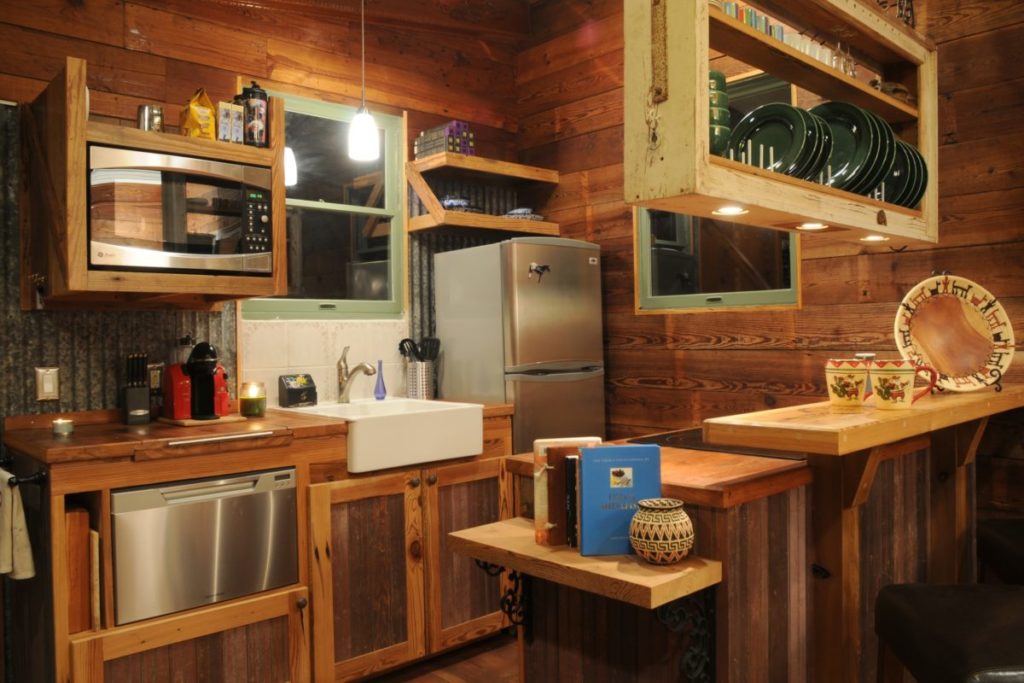When it comes to building a tiny home, the use of reclaimed materials can not only help reduce waste and lower construction costs, but also add unique character and charm to your dwelling.
From repurposed barn wood beams to salvaged brick facades, incorporating reclaimed materials into your design can create a one-of-a-kind, environmentally conscious home that showcases your commitment to sustainability.
With the growing popularity of tiny living and the increasing awareness of the importance of reducing our environmental footprint, using reclaimed materials in your tiny home build not only makes sense – it’s also a chance to create a space that reflects your values and dedication to eco-friendliness.
Reclaimed lumber
Consider using reclaimed lumber from old barns, factories, or other structures that are being torn down. This can include beams, flooring, and other structural elements.
Not only does it reduce the demand for new, virgin lumber, but it also gives new life to materials that would otherwise be discarded.
Reclaimed lumber can include beams, flooring, and other structural elements, each with its own unique character and history.
By incorporating reclaimed lumber into your renovation, you can not only reduce waste but also add a touch of warmth and personality to your space.
The exposed beams and flooring can create a rustic, vintage look that is both stylish and environmentally conscious.
Because reclaimed lumber is often already aged and seasoned, it can be less prone to warping and shrinking, making it a more stable choice for your renovation.
To find reclaimed lumber, you can look to local salvage yards, antique stores, or online marketplaces.
Be sure to inspect the materials thoroughly before purchasing, and consider factors such as moisture content, nailing patterns, and any signs of damage or infestation.
With the right preparation and care, reclaimed lumber can be a stunning and sustainable addition to your renovation project.
Repurposed metal
Use reclaimed metal from old cars, appliances, or other sources to create unique features like light fixtures, hooks, or even the frame of your tiny home.
Repurposed metal is a great way to add a touch of character and sustainability to your tiny home.
By using reclaimed metal from old cars, appliances, or other sources, you can create one-of-a-kind features like light fixtures, hooks, or even the frame of your home.
Not only does this help reduce waste and support sustainable living, but it also allows you to get creative and think outside the box.
For example, you could use reclaimed metal to create a stunning light fixture that serves as a focal point in your living area, or you could use it to create a set of hooks that add a touch of industrial chic to your mudroom.
The possibilities are endless, and the end result will be a unique and functional piece that adds warmth and personality to your tiny home.
Salvaged brick
If you’re building a tiny home on a concrete slab, consider using salvaged brick as a base for your foundation. This can help to reduce waste and create a more sustainable foundation.
Using salvaged brick as a base for your foundation when building a tiny home on a concrete slab is a sustainable and waste-reducing solution.
Not only does it repurpose materials that would otherwise end up in landfills, but it also provides a sturdy and long-lasting foundation.
Salvaged brick can be sourced from a variety of places, including historic buildings, demolition sites, and even from the ground itself.
By incorporating these reclaimed materials into your foundation, you can not only reduce waste but also create a unique and distinctive look for your tiny home.
Salvaged brick can help to improve the thermal mass of your home, which can help to regulate internal temperatures and reduce the need for heating and cooling.
By choosing this sustainable and innovative approach to foundation construction, you can create a foundation that is not only sturdy and long-lasting but also environmentally conscious.
Recycled glass
Use recycled glass as a sustainable alternative to traditional countertop materials. You can find recycled glass countertops made from a variety of sources, including beer bottles and wine bottles.
Recycled glass countertops offer a unique and eco-friendly solution for homeowners looking to upgrade their kitchen or bathroom surfaces.
These innovative countertops are made from recycled glass, sourced from a variety of sources such as beer bottles, wine bottles, and other glass products.
By utilizing recycled glass, the production of these countertops reduces the need for new raw materials, lowering the environmental impact of their creation.
Not only are recycled glass countertops a sustainable option, but they also offer a distinctive and stylish aesthetic.
With a range of colors and textures available, homeowners can choose a finish that complements their space and personal style.
Recycled glass countertops are durable and easy to maintain, making them a practical choice for busy households.
Whether you’re looking to upgrade your kitchen or bathroom, consider the sustainable and stylish option of recycled glass countertops.
With their unique blend of eco-friendliness and versatility, they’re sure to be a standout feature in your home.
Reused roofing materials
If you’re building a tiny home with a roof, consider using reused roofing materials like reclaimed shingles or metal roofing panels. These can be found at salvage yards or online.
When it comes to constructing your tiny home’s roof, considering the use of reused roofing materials like reclaimed shingles or metal roofing panels can be a cost-effective, sustainable, and creative option.
By sourcing these materials from salvage yards or online, you can give your home a unique and characterful look while also reducing waste and the environmental impact of new materials.
Reclaimed shingles, for example, can be found in various sizes, shapes, and colors, and can be repurposed to create a one-of-a-kind roofing design.
Not only do they add a touch of vintage charm to your home, but they also help to reduce the demand for new, resource-intensive roofing materials.
Similarly, metal roofing panels can be salvaged from old buildings or structures and repurposed for your tiny home.
These panels can be painted or coated with a protective finish to ensure they last for many years to come.
By choosing to use reused metal roofing panels, you’ll be diverting waste from landfills and minimizing the carbon footprint of your build.
In addition to their environmental benefits, reused roofing materials can also provide significant cost savings compared to new materials.
By opting for reclaimed shingles or metal roofing panels, you can reduce the overall expense of your tiny home build while still achieving a high-quality, durable roof.
Overall, using reused roofing materials like reclaimed shingles or metal roofing panels is a creative and eco-friendly option for your tiny home build.
Not only will you be salvaging materials that would otherwise end up in landfills, but you’ll also be creating a unique and sustainable living space that reflects your commitment to environmental stewardship. The Benefits of Reused Roofing Materials in Tiny Home Builds
When it comes to building a tiny home, one of the most important aspects to consider is the roof.
Not only does it provide protection from the elements, but it also plays a significant role in the home’s aesthetic and energy efficiency.
For those looking for an eco-friendly and cost-effective option, reused roofing materials are an excellent choice.
Reused roofing materials like reclaimed shingles or metal roofing panels offer a number of benefits.
First and foremost, they help to reduce waste by repurposing materials that would otherwise end up in landfills.
This is not only a great way to reduce your carbon footprint, but it also helps to conserve natural resources.
In addition to their environmental benefits, reused roofing materials can also provide significant cost savings.
Purchasing reclaimed shingles or metal roofing panels can be more affordable than buying new materials, especially when compared to traditional asphalt shingles.
Plus, these materials can last just as long, if not longer, than their newer counterparts.
Another benefit of reused roofing materials is their unique character.
Reclaimed shingles, for example, can add a rustic and charming touch to your tiny home’s roof, while metal roofing panels can provide a sleek and modern look.
This makes reused roofing materials a great way to add visual interest and personal style to your home.
When building a tiny home with a roof, consider using reused roofing materials like reclaimed shingles or metal roofing panels.
Not only do they offer environmental stewardship and cost savings, but they also add unique character and visual interest to your home’s roof.
With their many benefits, reused roofing materials are a practical and stylish choice for any tiny home owner.] When building a tiny home with a roof, there are several compelling reasons to consider using reused roofing materials like reclaimed shingles or metal roofing panels.
Not only can these materials help you save money compared to traditional asphalt shingles, but they also offer unique visual appeal and environmental benefits.
Reclaimed shingles, for instance, can add a charming, rustic touch to your tiny home’s roof, while metal roofing panels can provide a sleek and modern look.
This makes reused roofing materials an excellent way to personalize your home’s appearance while also making a positive impact on the environment.
One of the key advantages of reused roofing materials is their cost-effectiveness.
Purchasing reclaimed shingles or metal roofing panels can be significantly more affordable than buying new materials, especially when you consider the long-term savings that come with reduced waste and lower energy consumption.
Many reused roofing materials are available for purchase from local suppliers or online marketplaces, making it easy to find what you need without having to go to a big-box store.
Furthermore, using reused roofing materials in your tiny home’s construction can help reduce waste and support sustainability.
By repurposing materials that would otherwise be discarded, you are contributing to the reduction of landfill waste and the preservation of natural resources.
This makes reused roofing materials an attractive choice for those seeking an environmentally friendly and socially responsible tiny home design.
Considering the use of reused roofing materials in your tiny home’s construction is an excellent way to save money, enhance your home’s appearance, and support sustainability.
With so many stylish and cost-effective options available, there’s no reason not to explore this innovative solution for your tiny home’s roofing needs.
Vintage windows
Use vintage windows to create unique storage solutions or as decorative elements in your tiny home. You can find these at salvage yards, antique stores, or online.
Looking for a unique and creative way to store your belongings or add some vintage charm to your tiny home?
Consider incorporating vintage windows into your design!
These beautiful and functional elements can be found at salvage yards, antique stores, or online, and can be repurposed as storage solutions or decorative elements.
For example, you could use vintage windows as shelves or storage compartments, creating a one-of-a-kind display space for your favorite items.
Or, you could hang them as decorative elements, such as in a kitchen or dining area, adding a touch of vintage charm and character to your space.
To make the most of vintage windows in your tiny home, consider their size, style, and condition.
Larger windows can create more storage space, while smaller ones can be used as accent pieces.
Look for windows with interesting details, such as leaded glass or carved wood, to add additional visual interest.
And, be sure to clean and restore your vintage windows before incorporating them into your design, to ensure they are in good condition and safe to use.
By incorporating vintage windows into your tiny home design, you can create a unique and memorable space that reflects your personal style and love of history.
With a little creativity and some elbow grease, these beautiful pieces can become a stunning and functional part of your tiny home.
Upcycled plastic
Use upcycled plastic materials like plastic bottles or containers to create insulation, flooring, or other elements in your tiny home. You can find tutorials online for turning plastic bottles into insulation, for example.
Upcycling plastic materials into functional elements for your tiny home is a creative and eco-friendly way to reduce waste and improve insulation.
By using upcycled plastic bottles or containers, you can create durable and sustainable insulation, flooring, or other elements for your tiny home.
With a little bit of creativity and some tutorials available online, you can turn plastic bottles into insulation materials that can be used to line your walls or ceiling.
For example, you can use plastic bottles filled with insulation material to create a thermal barrier that keeps your home warm in the winter and cool in the summer.
Upcycled plastic can be used to create durable and water-resistant flooring that is easy to maintain and clean.
By incorporating upcycled plastic materials into your tiny home design, you can not only reduce your carbon footprint but also create a unique and environmentally friendly living space.
Reclaimed stone
Use reclaimed stone from old buildings or quarries to create feature walls, flooring, or other design elements in your tiny home. This can add a touch of history and character to your space.
Reclaimed stone is a brilliant option for adding a touch of history and character to your tiny home.
By incorporating reclaimed stone from old buildings or quarries, you can create stunning feature walls, flooring, or other design elements that will give your space a unique and timeless appeal.
The beauty of reclaimed stone lies in its patina, which is the accumulation of layers and textures that come from years of wear and tear.
This patina can range from a subtle softness to a dramatic, weathered look, and it will add a depth and warmth to your tiny home that is hard to replicate with new materials.
Furthermore, using reclaimed stone is an environmentally friendly choice, as it reduces the demand for new quarrying and mining.
By repurposing existing materials, you are not only saving resources but also giving old materials a new life.
Reclaimed stone can be sourced locally, which can help support your community and reduce transportation emissions.
When incorporating reclaimed stone into your tiny home, consider the style and color of the stone, as well as its texture and pattern.
For example, you could use rough-hewn stone for a rustic look or smooth, polished stone for a more modern aesthetic.
You can also mix and match different types of stone to create a unique and dynamic design.
With a little creativity and imagination, reclaimed stone can become a stunning focal point in your tiny home, adding warmth, character, and a touch of history to your compact living space.
Want More? Dive Deeper Here!
Hey there! If you’re the type who loves going down the rabbit hole of information (like we do), you’re in the right spot. We’ve pulled together some cool reads and resources that dive a bit deeper into the stuff we chat about on our site. Whether you’re just killing time or super into the topic, these picks might just be what you’re looking for. Happy reading!






